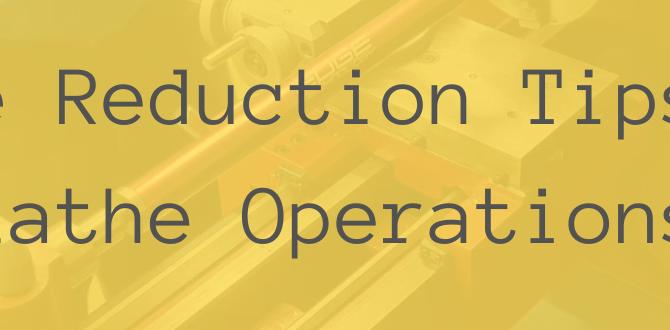Mastering Peek Adaptive Clearing with a 55-Degree Tialn Ball Nose End Mill: Your Ultimate Guide. Learn the secrets to efficient, smooth, and precise machining of PEEK plastic using this specialized tool. Get ready for cleaner cuts and longer tool life!
Hey everyone, Daniel Bates here from Lathe Hub! If you’ve ever tackled machining PEEK (Polyetheretherketone) plastic on your mill, you know it can present some unique challenges. It’s a fantastic material – strong, heat-resistant, and great for many demanding applications. But it can be gummy, melt easily, and leave you with a messy workpiece if you’re not careful.
The good news is, with the right tooling and techniques, you can achieve beautiful, clean results. Today, we’re diving deep into one of the most effective methods: adaptive clearing using a 55-degree Tialn ball nose end mill. This combination is a game-changer for PEEK. We’ll walk through exactly how it works, why it’s so effective, and the simple steps you need to follow to get started. You’ll be machining PEEK with confidence in no time!
What is PEEK and Why is it Tricky to Machine?
Before we get down to the nitty-gritty of the 55-degree Tialn ball nose end mill and adaptive clearing, let’s quickly talk about PEEK itself. PEEK is a high-performance thermoplastic polymer. Think of it as a super-tough plastic that can stand up to heat and wear better than many other plastics. This makes it ideal for parts in aerospace, medical devices, and industrial machinery.
So, why is it tricky? PEEK has a relatively low melting point compared to metals. This means if you apply too much heat during machining, it can start to soften, melt, or ‘gum up’ on your cutting tool. This leads to:
- Poor surface finish
- Inaccurate tolerances
- Tool breakage
- Excessive wear on your cutting edges
Traditional machining strategies can sometimes struggle with these issues, leading to frustration. That’s where specialized tools and techniques come in!
Introducing the 55-Degree Tialn Ball Nose End Mill for PEEK
Let’s talk about the star of our show: the 55-degree Tialn ball nose end mill. This isn’t just any end mill; it’s designed with specific features that make it perfect for materials like PEEK.
Ball Nose End Mill: This means the tip of the end mill is shaped like a hemisphere, or a ball. This shape is fantastic for creating smooth, contoured surfaces and for applications where you need to machine fillets or complex 3D shapes.
55-Degree Helix Angle: Most standard end mills have helix angles of 30 or 45 degrees. A 55-degree helix angle on a ball nose end mill offers a fantastic sweet spot for PEEK. It provides a good balance between chip clearance and cutting force. A steeper helix (like 45 degrees) might try to lift chips too aggressively, while a shallower one might not clear them well enough, leading to recutting and heat buildup. The 55-degree angle helps manage heat and provides a smoother cut.
TiAlN Coating: This is a Titanium Aluminum Nitride coating. It’s a thin, incredibly hard layer applied to the surface of the end mill. What does it do for you? It significantly increases the tool’s resistance to heat and abrasion. For PEEK, this is crucial. The TiAlN coating protects the cutting edge from the heat generated during machining, preventing it from softening and extending the life of your tool dramatically. You can learn more about tool coatings and their benefits on resources like the National Institute of Standards and Technology (NIST) website.
In short, this specific combination – a ball nose shape, a 55-degree helix, and a TiAlN coating – is engineered to tackle PEEK with superior performance.
Understanding Adaptive Clearing
Now that we know our tool, let’s discuss the machining strategy: adaptive clearing. If you’ve used traditional methods like pocketing, you know they often involve a lot of back-and-forth, leaving a lot of material for the tool to break through. Adaptive clearing is a more intelligent approach.
Instead of taking wide, heavy passes that can shock the tool and material, adaptive clearing focuses on maintaining a consistent chip load and keeping the tool engaged in a smooth, continuous path. Think of it like this:
- Traditional Pocketing: Like a snowplow pushing a huge pile of snow, often with jerky movements.
- Adaptive Clearing: Like a carefully choreographed dance, smoothly removing material in a way that minimizes stress on the tool and maximizes efficiency.
Here’s how it generally works:
The tool enters the material on a ramp or a trochoidal (circular) path, not plunging straight down. As it works its way through the pocket or open area, it follows a series of overlapping, high-speed, shallow cuts. The key is that the depth of cut remains relatively shallow, while the stepover (how much the tool moves sideways in each pass) is optimized. This ensures that the chip load (the thickness of the material being removed by each cutting edge) stays constant and manageable.
Benefits of Adaptive Clearing for PEEK:
- Reduced Heat Buildup: By taking lighter, more consistent passes and clearing chips effectively, less heat is generated.
- Increased Tool Life: Less heat and stress means your 55-degree Tialn ball nose end mill lasts much longer.
- Improved Surface Finish: Smooth, continuous cutting results in a much cleaner surface on your PEEK part.
- Faster Machining Times: While it might seem counterintuitive, these efficient strategies often lead to quicker cycle times because the machine is running at optimal speeds and feeds without stopping or struggling.
- Minimized Stress on the Part: Less force is applied to the PEEK, reducing the risk of warping or deformation.
This strategy is particularly well-suited for the 55-degree Tialn ball nose end mill because the tool’s geometry and coating complement the adaptive clearing principle perfectly.
Choosing the Right Tool Specifications
When you’re looking for your 55-degree Tialn ball nose end mill for PEEK, here are some key specs to keep in mind. Not all end mills are created equal, even if they share a name!
Diameter: The diameter of the end mill will depend on the smallest features you need to machine. For general PEEK work, diameters from 1/8″ (3mm) up to 1/2″ (12mm) are common.
Number of Flutes: For plastics like PEEK, you’ll typically want an end mill with fewer flutes. 2 or 3 flutes are usually ideal. Why?
- 2 Flutes: Excellent for plastics. They provide maximum chip clearance, which is crucial for preventing melting and gumming up.
- 3 Flutes: A good compromise if you need a bit more rigidity for certain cuts, but still offers good chip evacuation. More than 3 flutes can sometimes pack too much material in the flutes for gummy materials.
Shank Type: Ensure it has a standard Weldon shank or a shank suitable for your collet system. A secure grip is essential!
Material and Coating: As we discussed, look for solid carbide (often the best for high-performance tools) with a TiAlN coating. Some might also specify a “high-performance plastic” grade. Always confirm the coating!
Ball Nose Radius: The radius should be appropriate for the shapes you’re creating. A 55-degree ball nose end mill means the tip has a spherical radius. The larger the radius compared to the diameter, the more spherical the tip.
Example Table: Recommended End Mill Specs for PEEK Adaptive Clearing
| Feature | Recommendation for PEEK | Why it Matters |
|---|---|---|
| Tool Type | Ball Nose End Mill | For 3D contours and smooth fillets. |
| Helix Angle | 55 Degrees | Optimal balance for chip evacuation and smooth cutting in plastics. |
| Coating | TiAlN (Titanium Aluminum Nitride) | Provides high heat and wear resistance, crucial for PEEK. |
| Material | Solid Carbide | Offers rigidity and heat resistance. |
| Number of Flutes | 2 or 3 Flutes | Maximizes chip clearance, reducing melting and buildup. |
| Diameter | Varies (e.g., 1/8″ to 1/2″) | Depends on the smallest part features. |
Setting Up Your CNC Machine for Adaptive Clearing
Now, let’s get your machine ready. This involves setting up your CAM software (if you use one) and your machine parameters. If you’re manually programming, the principles still apply.
1. CAM Software Setup (If Applicable)
This is where adaptive clearing is most commonly programmed. Your CAM software will have specific strategies for this. Look for strategies like:
- Area Clearance
- Adaptive Clearing
- 3D Adaptive Clearing
- VoluMill (a popular adaptive strategy)
When setting up the toolpath, you’ll need to input the tool dimensions and select the parameters. Key settings to focus on:
- Stepdown (Axial Depth of Cut): This is how deep the tool cuts into the material in each pass. For PEEK, keep this shallow – often 0.010″ to 0.050″ (0.25mm to 1.25mm) depending on the tool diameter and machine rigidity.
- Stepover (Radial Stepover): This is the percentage of the tool diameter that the tool moves sideways in each step. For adaptive clearing, you’ll often use a smaller stepover than traditional pocketing, typically 10-40% of the tool diameter. This keeps the chip load consistent.
- Steparound (for Ball Nose): If you’re using a ball nose, there might be a “steparound” value. This controls how much the tool engages on the sides of the toolpath.
- Ramp Angle/Trochoidal Stepover: Ensure your software is set to enter the material using ramps or trochoidal moves, not straight plunging. A 1-3 degree ramp angle is common.
- Feed Rate and Spindle Speed: You’ll need to determine appropriate speeds and feeds. This is crucial and depends heavily on your specific end mill, machine, and the PEEK itself. We’ll cover this next.
2. Speeds and Feeds for PEEK
Getting the speeds and feeds right is critical for PEEK. Too slow, and you risk melting. Too fast, and you can chatter or break the tool. The goal is to shear the material cleanly, not rub it.
A good starting point for PEEK with a solid carbide, TiAlN coated end mill would be:
- Spindle Speed: 5,000 – 15,000 RPM. Higher speeds are often better for plastics as they allow for faster feed rates and thinner chips.
- Feed Rate: This is directly related to your spindle speed and chip load. A common chip load for PEEK might be around 0.001″ – 0.003″ (0.025mm – 0.075mm) per flute.
Calculation Example:
If you have a 1/4″ (6.35mm) diameter, 2-flute end mill, and you want a chip load of 0.002″ (0.05mm) per flute:
- Feed Rate = Number of Flutes × Chip Load × Spindle Speed
- Feed Rate = 2 flutes × 0.002″/flute × 10,000 RPM
- Feed Rate = 40 inches per minute (IPM)
Important Notes on Speeds and Feeds:
- Manufacturer Recommendations: Always check the end mill manufacturer’s recommendations first. They often provide starting points for various materials.
- Material Grade: Different grades of PEEK (e.g., filled vs. unfilled) can machine slightly differently.
- Machine Rigidity: A more rigid machine can handle faster cutting.
- Coolant/Lubrication: While PEEK machines dry, a light mist of air or a plastic-specific coolant can help manage heat. Ensure it’s suitable for plastics and doesn’t degrade the material. You can find advice on machining plastics from organizations like the Society of Plastics Engineers.
- Listen to Your Machine: The best indicator is often the sound of the cut – it should be a clean, consistent “chip-shearing” sound, not a squeal or a ragged grind.
3. Machine Setup Checklist
Before starting your first adaptive clearing job on PEEK:
- Secure Workholding: Ensure your PEEK part is rigidly clamped. Any movement will ruin the cut.
- Tool Length Measurement: Accurately measure your tool length.
- Spindle Check: Ensure your spindle is clean and running smoothly.
- Coolant/Air Blast: Have your air blast or mist system ready if you plan to use it.
- Clearance: Double-check your machine’s Z-axis clearances to avoid crashes.
Executing the Adaptive Clearing Process: Step-by-Step
Alright, you’ve got your tool, your CAM program (or manual strategy in mind), and your machine is ready. Let’s walk through running the adaptive clearing operation.
Step 1: Load Your 55-Degree Tialn Ball Nose End Mill
Carefully install your 55-degree Tialn ball nose end mill into your machine’s collet or tool holder. Ensure it’s seated properly and tightened securely. A loose tool is a recipe for disaster!
Step 2: Set Work Zero (Origin)
Set your X, Y, and Z zero point accurately on your PEEK workpiece. This is critical for the toolpath to be in the correct location.
Step 3: Perform a Dry Run
This is a crucial safety step. Before plunging into your valuable material, run your program with the spindle OFF but the machine executing all axis movements. Watch carefully to ensure the toolpath is as expected and there are no collisions or unexpected moves. This helps catch programming errors or setup mistakes.
Step 4: Initiate Cutting with Air Blast (or Mist if Used)
If you’re using an air blast or mist coolant, turn it on. Then, start the spindle at your programmed speed. You should hear it reach the target RPM without any unusual noises.
Step 5: Start the Adaptive Clearing Cut
Press the “Cycle Start” button on your CNC controller. Watch the initial engagement. The end mill should enter the material on a ramp or trochoidal path, not plunge straight down.
Step 6: Monitor the Cut
This is where you’re the operator!
- Listen: Pay close attention to the sound. A consistent, crisp sound means you’re cutting efficiently. A squealing or grinding sound indicates a problem, likely too slow a feed, too aggressive a cut, or chip buildup.
- Watch the Chip Evacuation: See if chips are being cleared away from the cutting zone. If chips look like they’re melting or recutting, you may need to adjust your feed rate or spindle speed, or increase air blast.
- Observe Surface Finish: Even during the cut, you can often see the quality of the surface being produced. It should be smooth and clean.
- Check Cutting Forces: While difficult to quantify without sensors, an experienced eye can tell if the machine is working too hard. If the spindle RPM drops significantly or the machine is vibrating excessively, stop the program.
Step 7: Program Completion
Once the adaptive clearing operation is finished, the tool will retract. Let the spindle coast down or pause before turning off the air blast. Remove the part (once safe to do so) and inspect it.
Step 8: Inspection and Iteration
Examine the machined surface. Is it smooth? Are the dimensions correct? Is there any sign of melting or excessive wear on the tool? Analyze the results and be prepared to make minor adjustments to your speeds, feeds, or cutter compensation for the next part or operation




